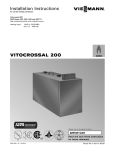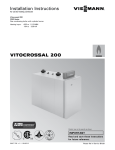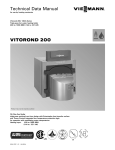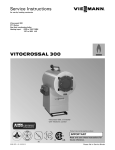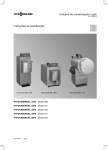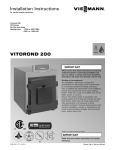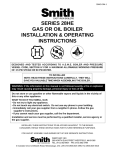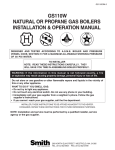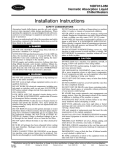Download Viessmann Vitocrossal 300 CT3 SERIES Unit installation
Transcript
Installation Instructions for use by heating contractor Vitocrossal 300 CT3 Series Gas-fired condensing boiler Heating input: 638 to 3361 MBH 187 to 985 kW VITOCROSSAL 300 IMPORTANT Please ensure that these instructions are read and understood before commencing installation and start-up. Failure to comply with these Installation Instructions will render all warranties null and void. Working on the equipment The installation, adjustment, service and maintenance of this product must be performed by a licensed professional heating contractor, who is qualified and experienced in the installation, service and maintenance of hot water heating boilers. There are no user serviceable parts on the boiler, burner, or control. Ensure main power supply to equipment, the heating system and all external controls has been deactivated. Close main oil or gas supply valve. Take precautions in all instances to avoid accidental activation of power during service work. Improper installation, service or maintenance can cause product/property damage, severe personal injury, and/or loss of life. Vitocrossal 300, CT3 boiler with Vitotronic control Product may not be exactly as shown IMPORTANT Read and save these instructions for future reference. 5285 873 - 02 12/2014 Please file in Service Binder Safety Vitocrossal 300, CT3 Series Installation Safety, Installation and Warranty Requirements Please ensure that these instructions are read and understood before commencing installation. Failure to comply with the instructions listed below and details printed in this manual can cause product/property damage, severe personal injury, and/or loss of life. Ensure all requirements below are understood and fulfilled (including detailed information found in manual subsections). Product documentation Read all applicable documentation before commencing installation. Store documentation near boiler in a readily accessible location for reference in the future by service personnel. For a listing of applicable literature, please see section entitled “Important Regulatory and Safety Requirements”. Licensed professional heating contractor The installation, adjustment, service and maintenance of this equipment must be performed by a licensed professional heating contractor. For information pertaining to the proper installation, adjustment, service and maintenance of this equipment to avoid formation of carbon monoxide, please see section entitled “Combustion air supply” and “Venting information” in this manual. Please see section entitled “Important Regulatory and Installation Requirements”. Contaminated air Air contaminated by chemicals can cause by-products in the combustion process, which are poisonous to inhabitants and destructive to Viessmann equipment. For a listing of chemicals which cannot be stored in or near the boiler room, please see section entitled “Mechanical Room”. in this manual. 2 Advice to owner Once the installation work is complete, the heating contractor must familiarize the system operator/ ultimate owner with all equipment, as well as safety precautions/requirements, shutdown procedure, and the need for professional service annually before the heating season begins. Warranty Information contained in this and related product documentation must be read and followed. Failure to do so renders the warranty null and void. Carbon monoxide Improper installation, adjustment, service and/or maintenance can cause flue products to flow into living space. Flue products contain poisonous carbon monoxide gas. Fresh air This equipment requires fresh air for safe operation and must be installed ensuring provisions for adequate combustion and ventilation air exist. For information pertaining to the fresh air requirements of this product, please see subsection entitled “Mechanical Room” in this manual. Equipment venting Never operate boiler without an installed venting system. An improper venting system can cause carbon monoxide poisoning. For information pertaining to venting and chimney requirements, please see section entitled “Venting Information” in this manual. All products of combustion must be safely vented to the outdoors. WARNING Installers must follow local regulations with respect to installation of carbon monoxide detectors. Follow the Viessmann maintenance schedule of the boiler in the “Service Instructions” manual. 5285 873 - 02 Safety Vitocrossal 300, CT3 Series Installation Safety, Installation and Warranty Requirements (continued) H Fiberglass wool and ceramic fiber materials WARNING Inhaling of fiberglass wool and/or ceramic fiber materials is a possible cancer hazard. These materials can also cause respiratory, skin and eye irritation. The state of California has listed the airborne fibers of these materials as a possible cancer hazard through inhalation. When handling these materials, special care must be applied. Suppliers of ceramic fiber products recommend the following first aid measures: - Respiratory tract (nose and throat) irritation: If respiratory tract irritation develops, move the person to a dust free location. - Eye irritation: If eyes become irritated, flush immediately with large amounts of lukewarm water for at least 15 minutes. Eyelids should be held away from the eyeball to ensure thorough rinsing. Do not rub eyes. - Skin irritation: If skin becomes irritated, remove soiled clothing. Do not rub or scratch exposed skin. Wash area of contact thoroughly with soap and water. Using a skin cream or lotion after washing may be helpful. 5285 873 - 02 - Gastrointestinal irritation: If gastrointestinal tract irritation develops, move the person to a dust free environment. Suppliers of fiberglass wool products recommend the following precautions be taken when handling these materials: Precautionary measures - Avoid breathing fiberglass dust and contact with skin and eyes. - Use NIOSH approved dust/mist respirator. - Wear long-sleeved, loose fitting clothing, gloves and eye protection. - Wash work clothes separately from other clothing. Rinse washer thoroughly. - Operations such as sawing, blowing, tear-out and spraying may generate airborne fiber concentration requiring additional protection. First aid measures - If eye contact occurs, flush eyes with water to remove dust. If symptoms persist, seek medical attention. - If skin contact occurs, wash affected areas gently with soap and warm water after handling. H Hazardous materials WARNING Appliance materials of construction, products of combustion and the fuel contain alumina, silica, heavy metals, carbon monoxide, nitrogen oxides, aldehydes and/or other toxic or harmful substances which can cause serious injury or loss of life and which are known to the State of California to cause cancer, birth defects and other reproductive harm. Always use proper safety clothing, respirators and equipment when servicing or working nearby the appliance. 3 Table of Contents Vitocrossal 300, CT3 Series Installation Page Safety Safety, Installation and Warranty Requirements..............2 Product documentation...........................................2 Licensed professional heating contractor ...................2 Contaminated air ...................................................2 Advice to owner ....................................................2 Warranty ..............................................................2 Carbon monoxide...................................................2 Fresh air ...............................................................2 Equipment venting .................................................2 Fiberglass wool and ceramic fiber materials ...............3 Suppliers of ceramic fiber products recommend the following first aid measures: ..............................3 Precautionary measures ..........................................3 First aid measures ..................................................3 Hazardous materials ...............................................3 Important Regulatory and Safety Requirements ..............6 Codes ..................................................................7 Working on the equipment ......................................7 Mechanical room ...................................................7 Technical literature ................................................7 General Information About these Instructions .............................................8 Product Information ....................................................8 Set-up Mechanical Room .......................................................9 Minimum Clearances...................................................9 Minimum Clearances to Combustibles ......................9 Recommended Service Clearances ...........................9 Mechanical room ...................................................9 Boiler Dimensions .....................................................11 Dimensions .........................................................11 Boiler Model ........................................................11 Boiler Handling, Positioning and Adjustments ...............12 Flue Gas Connections ...............................................12 Assembly Assembly When Supplied in Sections ..........................13 Boiler Connections Water Side Connections ............................................14 Hydrostatic Test Procedure........................................15 Vitocrossal 300, CT3-17 to -89 .............................15 Boiler Piping in Heating/Cooling Application .................16 Initial System Fill ......................................................17 Condensate Connection ............................................18 4 Condensate Disposal ................................................19 5285 873 - 02 Boiler Connections/Assembly Vitocrossal 300, CT3 Series Installation Table of Contents Page Assembly Insulation Installation ................................................19 Preparing the Control Unit Installation .........................22 Insulation Installation ................................................24 Back panel, combustion chamber door and cable channel installation ..............................................24 Top panel installation ...........................................25 Observation Port Installation ......................................26 Burner Installation ....................................................26 Burner Blast Tube Insulation ......................................27 Packing Materials.................................................27 Burner Settings ........................................................28 Venting Connection ..................................................28 Start-up Appendix Initial Start-Up .........................................................29 Pressure drop (primary circuit) ..............................29 Recommended Flow Rates ....................................29 Boiler model CT3 .................................................29 Technical Data .........................................................30 5285 873 - 02 Boiler Model ........................................................30 Input ..................................................................30 Output ...............................................................30 Combustion efficiency .........................................30 Thermal efficiency ..............................................30 Boiler output .......................................................30 Boiler standby loss ...............................................30 Dimensions - boiler shell .......................................30 Overall dimensions ...............................................30 Foundation..........................................................30 Weight ...............................................................30 Overall weight complete with insulation and control (less burner) .......................................................... 30 Boiler Model ........................................................31 Weight ...............................................................31 Overall weight complete with insul. and control (w/o burner) ........................................................31 Boiler water content .............................................31 Heat exchanger surface .......................................31 Max. operating temperature ..................................31 Max. operating pressure .......................................31 Flue gas resistance ..............................................31 Boiler connections................................................31 Vent pipe ............................................................31 Flue gas values ....................................................31 Pressure at boiler flue outlet ..................................31 5 Safety Vitocrossal 300, CT3 Series Installation Important Regulatory and Safety Requirements For installations on the Commonwealth of Massachusetts, the following modifications to NFPA-54 chapter 10 apply: Excerpt from 248 CMR 5-08: 2(a) For all side-wall horizontally vented gas fueled equipment installed in every dwelling, building or structure used in whole or in part for residential purposes, including those owned or operated by the Commonwealth and where the side-wall exhaust vent termination is less than (7) feet above finished grade in the area of the venting, including but not limited to decks and porches, the following requirements shall be satisfied: 1. INSTALLATION OF CARBON MONOXIDE DETECTORS. At the time of installation of the side-wall horizontal vented gas fueled equipment, the installing plumber or gas fitter shall observe that a hard wired carbon monoxide detector with an alarm and battery back-up is installed on the floor level where the gas equipment is to be installed. In addition, the installing plumber or gasfitter shall observe that a battery operated or hard wired carbon monoxide detector with an alarm is installed on each additional level of the dwelling, building or structure served by the side-wall horizontal vented gas fueled equipment. It shall be the responsibility of the property owner to secure the services of qualified licensed professional for the installation of hard-wired carbon monoxide detectors. a. In the event that the side-wall horizontally vented gas fueled equipment is installed in a crawl space or an attic, the hard-wired carbon monoxide detector with alarm and battery back-up may be installed on the next adjacent floor level. b. In the event that the requirements of this subdivision can not be met at the time of completion of installation, the owner shall have a period of thirty (30) days to comply with the above requirements; provided, however, that during said thirty (30) day period, a battery operated carbon monoxide detector with an alarm shall be installed. 2. APPROVED CARBON MONOXIDE DETECTORS. Each carbon monoxide detector as required in accordance with the above provisions shall comply with NFPA 720 and be ANSI/UL 2034 listed and IAS certified. 3. SIGNAGE. A metal or plastic identification plate shall be permanently mounted to the exterior of the building at a minimum height of eight (8) feet above grade directly in line with the exhaust vent terminal for the horizontally vented gas fueled heating appliance or equipment. The sign shall read, in print size no less than one-half (b) inch in size, "GAS VENT DIRECTLY BELOW. KEEP CLEAR OF ALL OBSTRUCTIONS". 4. INSPECTION. The state or local gas inspector of the side-wall horizontally vented gas fueled equipment shall not approve the installation unless, upon inspection, the inspector observes carbon monoxide detectors and signage installed in accordance with the provisions of 248 CMR 5.08(2)(a) 1 through 4. (b) EXEMPTIONS: The following equipment is exempt from 248 CMR 5.08(2)(a) 1 through 4: 1. The equipment listed in Chapter 10 entitled "Equipment Not Required To Be Vented" in the most current edition of NFPA 54 as adopted by the Board; and 6 5285 873 - 02 2. Product Approved side-wall horizontally vented gas fueled equipment installed in a room or structure separate from the dwelling, building or structure used in whole or in part for residential purposes. Safety Vitocrossal 300, CT3 Series Installation Important Regulatory and Safety Requirements (continued) Codes Mechanical room The installation of this unit shall be in accordance with local codes. In the absence of local codes, use: CAN/CSA-B149.1 or .2 Installation Note: Please carefully read this manual prior to attempting installation. Any warranty is null and void if these instructions are not followed. For information regarding other Viessmann System Technology componentry, please reference documentation of the respective product. We offer frequent installation and service seminars to familiarize our partners with our products. Please inquire. Ensure the mechanical room complies with the requirements of the System Design Guidelines and/or Technical Data Manual. In addition, see section entitled “Mechanical Room” on page 7 in this manual. Codes for Gas Burning Appliances for Canada. For U.S. installations, use the National Fuel Gas Code ANSI Z223.1. Always use latest editions of codes. Literature for the Vitocrossal 300, CT3 boiler: - Technical Data Manual - Installation Instructions - Service Instructions - Operating Instructions and User’s Information Manual - Instructions of other Viessmann products utilized with this installation - Installation codes mentioned in this manual For oil-fired boiler installation, use CSA B-139 in Canada and NFPA 31 in the U.S. Always use latest editions of codes. In Canada all electrical wiring is to be done in accordance with the latest edition of CSA C22.1 Part 1 and/or local codes. In the U.S., use the National Electrical Code ANSI/ NFPA 70. The heating contractor must also comply with the Standard for Controls and Safety Devices for Automatically Fired Boilers, ANSI/ASME CSD-1 where required by the authority having jurisdiction. Viessmann recommends installation of an additional electrical disconnect switch and a fuel shut-off valve (if possible) outside the mechanical room or enclosed area of installation. The maximum room temperature of the mechanical room where the boiler is located must not exceed 104° F (40° C). Technical literature Note: Leave all literature at the installation site and advise the system operator/ultimate owner where the literature can be found. Contact Viessmann for additional copies. For installation of the heating system as a whole, please refer to the technical literature of other System Technology devices: Working on the equipment - Installation Instructions for Viessmann boiler control The installation, adjustment, service, and maintenance of this boiler must be performed by a licensed professional heating contractor who is qualified and experienced in the installation, service, and maintenance of hot water boilers. There are no user serviceable parts on the boiler, burners, or control. - Installation Instructions for Viessmann indirect-fired hot water storage tank(s) - Installation Instructions for burner and accessories Note: The completeness and functionality of field supplied electrical controls and components must be verified by the heating contractor. This includes low water cut-offs, flow switches (if used), staging controls, pumps, motorized valves, air vents, thermostats, etc. 5285 873 - 02 Ensure main power supply to equipment, the heating system, and all external controls has been deactivated. Close main gas supply valve. Take precautions in all instances to avoid accidental activation of power during service work. 7 General Information Vitocrossal 300, CT3 Series Installation About these Instructions Take note of all symbols and notations intended to draw attention to potential hazards or important product information. These include “WARNING”, “CAUTION”, and “IMPORTANT”. See below. WARNING Warnings draw your attention to the presence of potential hazards or important product information. Indicates an imminently hazardous situation which, if not avoided, could result in loss of life, serious injury or substantial product/property damage. CAUTION Cautions draw your attention to the presence of potential hazards or important product information. Indicates an imminently hazardous situation which, if not avoided, may result in minor injury or product/ property damage. IMPORTANT Helpful hints for installation, operation or maintenance which pertain to the product. This symbol indicates that additional, pertinent information is to be found. This symbol indicates that other instructions must be referenced. Product Information WARNING Exposing the boiler to pressures and temperatures in excess of those listed will result in damages, and will render warranty null and void. High efficiency gas-fired hot water condensing boiler. For operation with modulating boiler water temperatures in closed loop, forced circulation hot water heating systems. The Vitocrossal 300, CT3 boilers are CSA certified with Weishaupt and Riello burners which must be used in conjunction with this boiler series. The proper burner size must be verified and the burner must be adjusted so that the maximum input of the appropriate boiler size is always observed and adjusted. The gas burner must always be installed according to the instructions provided by the burner manufacturer. The Vitocrossal 300 boiler is suitable for a maximum operating pressure of 30 psig and a maximum boiler water temperature of 210° F (99° C). This boiler does not require a flow switch. 8 5285 873 - 02 The boiler model selected should be based on an accurate heat loss calculation of the building. The boiler selected must be compatible with the connected radiation. Set-up Vitocrossal 300, CT3 Series Installation Mechanical Room The Vitocrossal 300, CT3 boiler should be located in a heated indoor space. The boiler should also be located near a floor drain and as close as possible to the vertical chimney or vent. Whenever possible, install boiler near an outside wall so that it is easy to duct fresh air directly to the boiler area. Do not use exhaust fans without adding additional provisions for fresh combustion air (e.g. fresh air fan) in the boiler room and do not install the Vitocrossal 300 boiler in rooms with refrigeration equipment. This boiler requires uncontaminated air for safe operation - do not install where chemicals are stored. Install boiler on flooring capable of supporting the weight of the boiler filled with water. Minimum Clearances Minimum Clearances to Combustibles Boiler model CT3- z 17 w A 20 in. (500 mm) 20 in. (500 mm) B 28 37 46 57 72 89 6 in. (150 mm) Sides v 22 6 in. (150 mm) Top Flue As per vent manufacturer’s specification Front 6 in. (150 mm) Floor combustible Recommended Service Clearances x Length of burner y 8 in. (200 mm) To enable convenient installation and maintenance, observe the stated clearance dimensions. Maintain the minimum clearances where space is tight. In the factory set condition, the boiler door opens to the right. You can relocate the hinge bolts so that the door can open to the left. Mechanical room H Do not operate when air is polluted with halogenated hydrocarbons (e.g. as in aerosols, paints, solvents and cleaning agents) Legend A Boiler B Burner H Prevent very dusty conditions H Prevent high levels of humidity H Prevent freezing and ensure good ventilation Otherwise, the system may suffer faults and damage. 5285 873 - 02 Boiler model CT3V in. (mm) W in. (mm) X in. (mm) Y in. (mm) Z in. (mm) 17 28 (711) 62c (1593) 36b (930) 40 (1012) 22 28 (711) 65c (1671) 39a (1000) 40 (1012) 28 28 (711) 69 (1752) 41a (1048) 41a (1048) 41a (1048) 43a (1100) 40 (1012) 37 35 (889) 72 (1828) 59 (1500) 46 35 (889) 75 (1906) 59 (1500) 57 39 (991) 81a (2062) 59 (1500) 44b (1128) 45a (1149) 44b (1128) 45a (1149) 44b (1128) 45a (1149) 72 45 (1143) 85b (2172) 59 (1500) 49 (1243) 48 (1219) 89 45 (1143) 93a (2366) 59 (1500) 49 (1243) 48 (1219) 9 Set-up Vitocrossal 300, CT3 Series Installation Minimum Clearances (continued) Overall length Length Overall width Width 1 with IN 1 BS SH BTS OP SS min. 5b in. (140 mm) *1 IO CD Length of boiler pad 10 BR2 BR1 D V 12 in. (160 mm) Width 2 Width 2 with IN 2 Note: - Boiler shell, overall and foundation dimensions listed on page 29. - Minimum shipping dimensions: use “o” in the table below, and height, width 1 in the diagram above. *1 The minimum combustion head length of 5½ in. (140 mm) must be maintained. When a burner with a shorter combustion head is used, all functions including combustion results must be verified. The maximum combustion head length must also be observed so that the burner on the hinged combustion chamber door can swing into service position. Radius of door hinge to outside combustion head: 18¾ in. (476 mm). 5285 873 - 02 Legend V Vent pipe connection SH Female connection R½ in. for air vent and pressure gage D Drain CD Condensate drain BR 1 Boiler return 1 BR 2 Boiler return 2 BTS Boiler temperature sensor BD Boiler door with burner connecting flange BS Boiler supply IO Inspection opening SS Safety supply for pressure relief valve OP Observation port (boiler from CT3-17 - 28: offset by 90º ) IN Insulation Overall height Height BD Width 1 Set-up Vitocrossal 300, CT3 Series Installation Boiler Dimensions Dimensions Boiler Model CT3- 17 22 28 37 48 57 72 89 a in. (mm) in. (mm) in. (mm) 28c (715) 11c (298) 20b (518) 28c (715) 11c (298) 20b (518) 28c (715) 11c (298) 20b (529) 62c (1594) 64c (1644) 64c (1644) 29c (751) 12c (325) 22c (577) 73 (1854) 29c (751) 14a (363) 25a (644) in. (mm) 29c (751) 12c (325) 22c (577) 73 (1854) 29c (751) 14a (363) 25a (644) d 29c (751) 12c (325) 22c (577) 73 (1854) 80b (2043) 80b (2043) e in. (mm) 74 (1879) 76 (1929) 76a (1937) 85b (2185) 86 (2185) 86 (2185) 95a (2417) 95a (2417) f in. (mm) 7 (177) 7 (177) 7 (177) 9b (200) 9b (200) 9b (200) 11 (280) 11 (280) g in. (mm) 9 (227) 9 (227) 9 (221) 8 (241) 8 (241) 8 (241) 10 (250) 10 (250) h in. (mm) 33b (852) 10 (257) 36a (921) 36a (921) 38 (965) 38 (965) in. (mm) in. (mm) 33b (852) 10 (257) 36a (921) k 31b (802) 10 (257) 11a (284) 11a (284) 11a (284) 14 (360) 14 (360) 51a (1299) 53 (1349) 53 (1349) 59 (1500) 59 (1500) 59 (1500) 63c (1621) 63c (1621) 7b (194) 5b (141) 37 (942) 7b (194) 5b (141) 40 (1020) 7b (190) 3 (79) 7b (190) 3 (79) 7b (190) 3 (79) 35a (973) 42b (1079) 47 (1192) 45b (1157) 50 (1270) 51b (1313) 56a (1426) 7c (197) 2b (65) 55a (1405) 56a (1426) 7c (197) 2b (65) 63 (1599) 35a (895) 7b (194) 4c (121) 42b (1081) 41a (1051) b c l m n 5285 873 - 02 o (split boiler shipping length) Recommended Boiler pad in. (mm) ) in. (mm) in. (mm) in. (mm) 63c (1621) 11 Set-up Vitocrossal 300, CT3 Series Installation Boiler Handling, Positioning and Adjustments Please observe the minimum clearances starting on page 8. The boiler itself is mounted on a boiler pad. This boiler pad should be placed on a concrete or equivalent foundation. A recommended foundation size for each boiler model can be found on page 29. The minimum height should not be less than 4 in. (100 mm). 1. Remove wooden shipping blocks from boiler base. 2. Remove the 4 leveling bolts from boiler skid and insert in the boiler skid. It is recommended to place a flat piece of steel plate under each floor leveling bolt for better weight distribution and adjustment, and to compensate for an uneven floor. 3. By adjusting the floor leveling bolts and, if necessary, adding a heavier steel plate, most of an uneven floor can be properly corrected. Flue Gas Connections Internal Ø of the flue outlet at: CT3-17 to 28 8 in. (201 mm) CT3-37 to 57 9¾ in. (251 mm) CT3-72 to 89 11¾ in. (301 mm) 12 5285 873 - 02 See flue gas system installation instructions. Assembly Vitocrossal 300, CT3 Series Installation Assembly When Supplied in Sections CAUTION Do not put any tools or any other objects into the combustion chamber. 1. Release the turnbuckles and screws M 12 on the bottom of the boiler body, pull the boiler front section out of the turnbuckles and remove it. IMPORTANT Do not use solvents. Use only clean towels and/or rags. 2. Secure supplied masking tape to all joints on the inside of the combustion chamber to prevent sealant adhering to these areas. Attach adhesive tape on the rear boiler section approx. 8 to 10 mm behind the front edge. 3. Evenly and generously apply the sealant supplied into the annular groove on the front section of the combustion chamber. Use supplied gasketing material only. 4. The combustion chamber front portion must then be aligned onto the main pressure vessel part and bolted to the same with the two bolt clamps provided on each vessel section together with the bolts and nuts M16 x 150. Insert gasket on boiler connection flange and tighten flange with nuts and bolts provided. Attach lower section of front combustion chamber to main vessel with nuts and bolts M12 x 25 as provided. 5285 873 - 02 5. Insert the supplied gasket in contact with the water side between the boiler sections and connect the proper flanges with nuts and bolts. 6. Secure the front section of the combustion chamber at the lower end with screws M12 x 45 and nuts. 7. Using empty silicone tubes, remove all protruding silicone sealant inside the combustion chamber. Ensure sufficient sealant has been applied all around to prevent any gaps appearing in the combustion chamber. Using rubber gloves or a plastic trowel, smooth the silicone joints. 8. Remove the adhesive tape when the sealant has sufficiently dried (approx. four hours). 9. Position gaskets (in the pack supplied) onto both top flanges and fit the pipework to the water side. Connect flanges with supplied nuts and bolts. 13 Boiler Connections Vitocrossal 300, CT3 Series Installation Water Side Connections 1. The existing heating system must be properly flushed, especially if the Vitocrossal 300 boiler is connected to an existing heating system in a retrofit application. 2. Connect the boiler to the system according the diagram. The sizes of all connections are given in the table on page 30. The Vitocrossal 300 boiler has two boiler return connections. If the heating system to be connected to the Vitocrossal 300 has two separate heating loops or circuits, the heating circuit or loop with the lower return temperature should be connected to boiler return. 1. All connections which are not being utilized for water connections or for controls must be properly closed. 3. The supplied air vent and pressure relief valve must be installed on the top of the boiler - the alternate pressure relief valve location may be in the safety supply. The piping to the precharged expansion tank, as well as any automatic feed water required, must be connected to the boiler drain opening or the safety return connection. 4. The supplied low water cut-off should be installed in the boiler return piping above the pressure vessel or may be installed directly on top of the boiler. Boiler return 1 Safety return boiler return 2 Boiler supply Condensate drain Flue gas damper Vent pipe Legend A High temp. heating loop B Low temp. heating loop C Pressure relief valve (must be installed within first 12 in. (305 mm) of piping) D Safety supply - alternate pressure relief valve location and additional supply E Drain valve F Precharged expansion tank G Automatic fill H Low water cut-off (install low water cut-off in boiler supply or boiler return with min. height at boiler supply) I Temperature gauge. Install temperature gauge as close as possible to the boiler supply line. 14 Note: - Piping diagrams for specific system layouts are available. Please enquire with your local Viessmann sales representative. 5285 873 - 02 Air vent and pressure gage Boiler Connections Vitocrossal 300, CT3 Series Installation Hydrostatic Test Procedure Vitocrossal 300, CT3-17 to -89 All Vitocrossal boilers are factory tested (hydrostatic testing) to ASME requirements. The following testing procedure is to ensure that the boiler remained intact during shipping and handling. 1. Isolate boiler from hydronic heating system using isolating valves (i.e. expansion tank, feed water valve, pressure relief valve etc.). 2. Remove 30 psig pressure relief valve from the boiler and cap pipe outlet. 3. Fill boiler with city water and pressurize it to one and a half (1½) times the maximum working pressure of boiler. The pressure must be controlled such that it will never be 10 psig higher than the testing pressure. Max. allowable working pressure = 30 psig Testing pressure = 45 psig (do not exceed 55 psig) WARNING Never expose the boiler to any pressures higher than 55 psig during testing. 5285 873 - 02 Legend A Boiler return 1 (BR1 - low temp.) B Drain C Boiler return 2 (BR2 - high temp.) / safety return D Boiler temperature sensor/AHL/FHL E Safety supply, alternative pressure relief valve location and additional boiler supply F ¾ in. coupling for additional control equipment G Boiler supply H Coupling for air vent / pressure gage K Condensate drain L Condensate inspection cover M Flue gas damper 4. Monitor pressure over a period of approximately one (1) hour to ensure that the pressure remains constant and steady at 45 psig. 5. Should there be a drop in pressure, ensure that all fittings are secure and tight. Check all flanged connections with a flashlight. 6. Remove the condensate collection inspection cover and observe the condensate drum for system water or fluid. 7. With a flashlight, observe and check the lower portion of the Inox-Crossal® wafer heat exchanger sections for system water or fluid. 8. Open the boiler combustion chamber door and inspect with a flashlight the top portion of the Inox-Crossal® wafer heat exchanger sections for system water or fluid. 9. If test is successful, reinstall all hydronic system components and refill the boiler with water or system fluid. 15 Boiler Connections Vitocrossal 300, CT3 Series Installation Boiler Piping in Heating/Cooling Application Cooling unit Heating/ Cooling unit Heating/ Cooling unit Heating/ Water chiller The boiler, when used in connection with a refrigeration system, must be installed so that the chilled medium is piped in parallel to the boiler with appropriate valves to prevent the chilled medium from entering the boiler. The boiler piping system of a hot water heating boiler connected to heating coils located in air handling units where they may be exposed to refrigerated air circulation must be equipped with flow control valves or other automatic means to prevent gravity circulation of the boiler water during the cooling cycle. Check installation instructions of chiller manufacturer carefully for additional requirements. Cooling season starts: Close valve V1 and open valve V2. Heating season starts: Close valve V2 and open valve V1. 16 A metal tag should be attached to these valves as to purpose. IMPORTANT In the above system, the circulating pump must be operated from a separate on/off switch - not from the boiler control. 5285 873 - 02 Legend A System supply B System return C Valve D Flow-check valve E Circulation pump F Automatic feed valve G Pre-charged expansion tank Boiler Connections Vitocrossal 300, CT3 Series Installation Initial System Fill Treatment of boiler feed water should be considered in areas of known problems, such as high mineral content and hardness. In areas where freezing might occur, an antifreeze may be added to the system water to protect the system (maximum mix ratio - 50% / 50%). Please adhere to the specifications given by the antifreeze manufacturer. Do not use automotive glycol! Please observe that an antifreeze/water mixture may require a backflow preventer within the automatic water feed and influence components such as diaphragm expansion tanks, radiation etc. A 40% antifreeze content will provide freeze-up protection to -31° F (-25° C). Do not use antifreeze other than specifically made for hot water systems. The heating system may also contain components which may be negatively affected by antifreeze. Check entire system frequently when filled with antifreeze. Read boiler service checklist for further information on water quality. CAUTION Before the heating boiler is installed and piped into an existing system, the heating system itself must be properly flushed to remove dirt and system sludge. Accumulations in old heating systems will tend to settle in the boiler and can lead to deposits which can cause hot spots, noise and water-side corrosion. For damages resulting from those kinds of impurities, the warranty will be null and void. The Vitocrossal 300 boiler is only suitable for closed hot water heating systems with pumps. The pressure relief valve must be attached to the top tapping on the boiler shell as per diagram on page 13, or onto the safety supply of the boiler. No valve, shut-off device, or obstruction of any kind and construction must be used between boiler and relief valve or on the discharge side of the pressure relief valve. The discharge side of the pressure relief valve must be continued in the same size as the outlet horizontally over the side of the boiler, and then vertically downwards to end approximately 1 ft. (300 mm) above the floor, and piped as close to a floor drain as possible. Do not install this discharge pipe to the outdoors or any area where freezing might occur or the discharge pipe could endanger life and equipment. Secure the discharge piping from the pressure relief valve with the appropriate hangers or brackets. IMPORTANT Ensure that there is no leak on any of the connections which are covered by the insulation. The boiler should be filled and properly bled of air, and the cold water fill pressure should not exceed 18 - 20 psig. All openings, as well as pipe connections on the boiler, should be observed for possible leaks. Once all connections are tight, the insulation can be mounted. IMPORTANT Cold water fill pressure must equal expansion tank pressure. It is strongly recommended to install boiler isolation valves, and above these isolation valves, drain valves in the system supply and return. This way, in case of maintenance work on the boiler or the heating system, it is not required to drain the entire system. When the boiler is utilized to supply heat to an indirectly heated domestic hot water tank as well, it is necessary that the heating loops without a mixing valve are equipped with flow check valves on the discharge side of the pumps to avoid reverse flow. IMPORTANT 5285 873 - 02 All system pumps must be installed from boiler supply to the system. 17 Boiler Connections Vitocrossal 300, CT3 Series Installation Condensate Connection emp as t t g e Flu ll inpu u at f p tem gas ad Flue rtial lo a at p Boiler water return temperature Flue gas temperature gross of e nt at ou ns m e A ond c Amount of condensate Note: The “amount of condensate” and the “flue gas temperature gross” graphs are independent of each other. 1. Locate the neutralization unit either behind or next to the boiler. 2. Trim the plastic hose supplied to the required dimension, and connect it as a P-trap (or with a siphon) to the condensate drain and the neutralization unit. If the condensate outlet of the Vitocrossal 300 boiler is lower than the drain, a condensate pump must be installed. Select a pump which is approved for condensing boiler applications. To avoid condensate spillage, select a pump with an overflow switch. The drain connection must terminate into an open or vented drain as close to the boiler as possible to prevent siphoning of the boiler drain. IMPORTANT Pipe ventilation must take place between the siphon trap and the neutralization unit (if applicable). IMPORTANT Always connect the drain with a P-trap or siphon to prevent flue gas from escaping into the space. 3. Connect the neutralization unit to the dewatering system. 18 5285 873 - 02 The amount of condensate to be expected during the operation of the boiler can be read from the diagram on the left. Boiler Connections/Assembly Vitocrossal 300, CT3 Series Installation Condensate Disposal All condensate disposal piping from boiler and from vent pipe system can be made from stainless steel, CPVC, or the appropriate rubber hose material as long as there is a P-trap installed in the disposal lines to avoid flue gas spillage through the condensate lines. The condensate occurring will show a reading of between 3 and 4 on the pH scale. If local building requirements demand neutralizing the condensate before disposal, contact Viessmann Manufacturing Company Inc. for a correctly sized neutralization tank. The treated condensate will show pH values of between 6.5 and 9 and can then be disposed of into the waste water system. The condensate drain to the sewer connection must be accessible to inspection. Route it with a gradient and equip the pipe with a P-trap; also provide suitable facilities for taking samples. The bottom drain should be located below the antiflooding level of the flue gas collector box. Condensate drains must only be made from corrosion resistant materials (e.g. fiber reinforced hoses). Never use any galvanized materials or those containing copper or black iron for pipes, connectors, etc. Install a P-trap in the condensate drain to prevent flue gases from escaping. Ensure that the domestic drainage systems are made from materials which are resistant to acidic condensate, e.g.: H Stoneware pipes H Hard PVC pipes H PVC pipes H PE-HD pipes H PP pipes H ABS/ASA pipes H Stainless steel pipes 5285 873 - 02 H Borosilicate pipes 19 Assembly Vitocrossal 300, CT3 Series Installation Insulation Installation CAUTION Do not put any tools or any other objects into the combustion chamber. All necessary parts are packed and shipped inside the insulation cartons. The installation of the insulation should only be performed once all the piping has been attached to the boiler shell and all access openings are properly closed. See following pages for installation steps. Remove combustion chamber door. Remove all hexagon bolts and the two hinge pins. 2. Mount the three distance bolts to the threaded openings provided on the top of the boiler shell. 3. Mount the three mounting brackets (long) complete with bolts and washers to the boiler front. 4. Mount the three mounting brackets (short) complete with bolts and washers to boiler rear. 5. Mount large rear insulation blanket (black nylon backing facing out) on top of main vessel, sliding it through the boiler supply header. 6. Insert four spacer bolts M8 x 105 into the threaded holes in the front and back of the boiler. 7. Mount small front insulation blanket (black nylon backing facing out) on top of front combustion chamber. Ensure that all pipe connections and distance bolts are properly pushed through, and secure with supplied spring hooks. 8. Mount lower front and lower rear insulation blankets over the distance brackets and secure in place with supplied spring hooks. 9. Install top rear and top front insulation blankets. Ensure that all brackets and openings for the attachment of bolts, brackets and pipe connections are properly pushed through. 5285 873 - 02 20 1. Assembly Vitocrossal 300, CT3 Series Installation Insulation Installation (continued) 10. Attach front panel with three screws M 8 x 10 to the mounting brackets. 11. Attach the back panels with three screws M 8 x 10 to the mounting brackets. 12. Attach the short side panel to the side where the control unit is to be installed. 13. Attach both side panels with screws M 8 x 40 to the center front and bottom back panels. 14. Secure the bottom front panel with screws M 8×40 to the side panels. IMPORTANT 5285 873 - 02 Depending on the burner/controls configuration, the following installation steps may not be all applicable. Check documentation supplied with the control unit specific to the project at hand. 21 Assembly Vitocrossal 300, CT3 Series Installation Preparing the Control Unit Installation 1. Attach the bottom of the mounting panel A with self-tapping screws B 3.9×9.5 to the side panel. 2. Attach the mounting panel B with two self-tapping screws B 3.9×9.5 on the back of the mounting panel (closed side oriented towards the boiler door). 3. Hook the rear of the control unit into the hooks on the rear wall of the panel. 4. Pull burner cables forward through the clean-out aperture (position surplus cable lengths above the side panel). IMPORTANT Control cabling may not be exactly as illustrated. Follow Vitotronic control installation instructions for proper cabling. 5. Attach the back of the control unit with self-tapping screws B 3.9×30 on the back of the mounting panel B. 6. Guide the boiler temperature sensor lead c (supplied with the control unit) through the knockout of the mounting panel A and through the aperture in the side panel, and push the back of the control unit forward through the opening (position excess leads above the side panel). IMPORTANT Control cabling may not be exactly as illustrated. Follow Vitotronic control installation instructions for proper cabling. CAUTION Do not kink the capillary tubes, otherwise the sensor function might be compromised. 22 Guide the capillary tubes through the knockout of the mounting panel A and the side panel opening (position excess lengths of leads above the side panel). 5285 873 - 02 7. Assembly Vitocrossal 300, CT3 Series Installation Preparing the Control Unit Installation (continued) CAUTION Maximum allowable operating temperature (fixed high limit) is 99° C (210 ° F). IMPORTANT For Viessmann pre-assembled control panels, follow instructions supplied with control panel. 8. Attach the side panel with the control unit above the short side panel using four screws M 8×40. 9. Guide the boiler temperature sensor and capillary tubes to the sensor well, and push in as far as possible. 10. Guide the burner cables to the front. CAUTION 5285 873 - 02 Do not kink the capillaries. A defective capillary will render the control inoperable. 23 Assembly Vitocrossal 300, CT3 Series Installation Insulation Installation Back panel, combustion chamber door and cable channel installation 1. Fit the finned panels on the top left, center and bottom left together using pan head screws M 6×10. 2. Hook the left finned panels into the threads of the spacer bolts and locate them in the side panel tab. 3. Fit the finned panels on the top right, center and bottom together using pan head screws M 6×10. 4. Hook the right finned panels into the threads of the spacer studs and locate them in the side panel tab. 5. Attach the finned panels with M 8 nuts and washers on the spacer studs, and secure together with selftapping screws B 3.9×9.5. 6. Attach the bottom of the finned panels with selftapping screws B 3.9×9.5. 7. Attach the front panel onto the top of the finned panels, and secure with screws M 8×10. Refer to the Installation Instructions for Vitotronic controls. 24 5285 873 - 02 8. Thermally insulate the connecting pipe to the boiler flow (horizontal pipe at the top of the boiler) using suitable material. Assembly Vitocrossal 300, CT3 Series Installation Insulation Installation (continued) 5285 873 - 02 Top panel installation 1. Fit the back panel onto the top of the boiler, push the finned panels into the tabs and secure with four screws M 8×10 to the threaded studs. 2. Attach the round cover and cover plate with selftapping screws B 3.9×9.5 to the top of the back panel. 3. Attach the strain relief to the burner cable. 4. Install the boiler door; insert hinge pins, secure them with cotter pins and hexagon screws. 5. Pull all external cables through the cable duct to the control unit. 6. Install connection box cover and secure with supplied self-tapping screws. 25 Assembly Vitocrossal 300, CT3 Series Installation Observation Port Installation The combustion chamber is equipped with an observation port for the burner flame and combustionchamber. The standard equipment includes a plastic hose A, a brass nipple B, and gaskets C. The brass nipple is to be installed in the tube part of the observation port. One end of the plastic hose attaches to the nipple. The other end must be extended inside the burner housing where it is attached to the blower housing. A minute amount of air then purges the observation port glass during burner operation and will keep the glass from fogging up. Legend A Plastic hose B Brass nipple C Gaskets Burner Installation IMPORTANT The combustion head of the burner must protrude through the insulation of the combustion chamber door, and the minimum of 5½ in. (140 mm) of the combustion head length must be maintained (total length from flange). In case a shorter combustion head is used, all combustion results during all firing stages must be properly verified. CAUTION The temperature resistance of the combustion head must be a minimum of 932° F (500° C). For burner installation see instructions supplied by burner manufacturer The proper burner plate for desired burner is supplied by Viessmann H Install the burner plate (part of the standard delivery). H Once the burner has been mounted with the combustion head, the door must be opened and any gap between the combustion chamber door insulation and the combustion head must be properly filled with supplied Fiberfrax insulation material. See Burner Blast Tube Insulation Installation Instructions on following page IMPORTANT 26 5285 873 - 02 Due to the location of the observation port in the combustion chamber door, it might be necessary to rotate the burner 180°. The burner itself can be installed in this position. It does not adversely affect the burner operation. The gas piping will then be on top of the burner rather than on the bottom (Weishaupt WG20 only). Assembly Vitocrossal 300, CT3 Series Installation Burner Blast Tube Insulation Packing Materials IMPORTANT The combustion chamber door opening is smaller in diameter than the burner blast tube. Do not attempt to force the burner blast tube inside the combustion chamber door. This may damage the combustion chamber door refractory. Follow these steps: 1. Measure the blast tube diameter. 2. Using a utility knife and narrow blade saw, cut the combustion chamber door to the required diameter of the blast tube. 3. Proceed with instructions below. 1. Mount burner plate A on combustion chamber door B (if not already factory installed). 2. Mount burner (not shown) on burner plate A. 3. Ensure that burner blast tube FiberFrax insulation (Part No. 7308 387) is filled between the burner blast tube D and the combustion chamber door refractory as shown C (shaded area). WARNING Without proper insulation, flue gases may leak out from combustion chamber door, causing condensation and corrosion. Also, combustion chamber door and burner plate will be subject to excessive temperatures. Ensure blast tube insulation is packed in such a fashion that it is flush with the combustion chamber door as shown. 5285 873 - 02 Note: Cross-section, combustion chamber door (may not be exactly as illustrated) 27 Assembly Vitocrossal 300, CT3 Series Installation Burner Settings CAUTION Do not exceed the maximum gas input of a particular boiler model. At the highest burner stage verify the maximum input by clocking gas meter. See instructions supplied by burner manufacturer Venting Connection Do not use any other vent material. Do not use galvanized pipe, plastic pipe and/or B-vent/Lvent chimney liners of any kind. WARNING The use of vent material other than AL29-4C stainless steel, positive pressure vent pipe and fittings, can cause property damage, severe personal injury and/or loss of life. Flexmaster Canada Limited 452 Attwell Drive Etobicoke, ON M9W 5C3 Tel.: (416) 679-0045 Fax: (416) 679-0051 Selkirk Canada Corporation 375 Green Road Stoney Creek, ON L8E 4A5 Tel.: (905) 662-6600 Fax: (905) 662-5352 (US) 1-800-992-8368 (Canada) 1-888-735-5475 Email: [email protected] Web: www.selkirkchimney.com 28 Use an AL29-4C® special stainless steel venting system (UL/ULC/CSA listed for category IV) for vertical venting of the Vitocrossal 300 boiler. Contact one of the following suppliers to order. The following chimney manufacturers may be contacted for assistance in designing the appropriate venting system for this type of boiler. ProTech Systems Inc. 26 Gansevoort Street Albany, NY 12202 Tel.: (518) 463-7284 Toll free: 1-800-766-3473 Fax: (518) 463-5271 Security Chimneys International Ltd. 2125 Rue Monterey, Laval, Quebec H7L 3T6 Tel. 450-973-9999 (US) 1-800-361-4909 (Canada) 1-800-667-3387 Fax: 450-973-2222 Email: [email protected] Web: www.securitychimneys.com 5285 873 - 02 IMPORTANT Start-Up Vitocrossal 300, CT3 Series Installation Initial Start-Up Pressure drop (primary circuit) The Vitocrossal 300 boiler is only suitable for heating systems with pumped heating water. For start-up and adjustments, see the service instructions for boiler, burner and boiler control unit CAUTION Pressure drop Do not fire the burner unless boiler and heating system are properly filled with water and purged of any air. Flow rate Legend A CT3-17 to -22 B CT3-28 C CT3-37 to -57 D CT3-72 to -89 Recommended Flow Rates Boiler model CT3- 17 22 28 37 46 57 72 89 20° F ∆t GPM 61 81 103 134 166 208 260 323 40° F ∆t GPM 31 41 52 67 83 104 130 162 11° C ∆t L/s 3.9 5.1 6.5 8.5 10.5 13.2 16.5 20.4 22° C ∆t L/s 2.0 2.6 3.3 4.2 5.3 6.6 8.2 10.3 5285 873 - 02 ∆t = temperature difference This boiler does not require a flow switch. 29 Appendix Vitocrossal 300, CT3 Series Installation Technical Data CT3- Input MBH (kW) MBH (kW) MBH MBH MBH (kW) 638 846 1071 1389 1726 2160 2702 3361 (187) (248) (314) (407) (506) (633) (792) (985) 626 827 1044 1350 1675 2094 2616 3252 (183) (242) (306) (396) (491) (614) (767) (953) 98.3 97.8 97.4 97.2 97.1 96.9 96.8 96.7 98.1 97.7 97.4 97.2 97.1 96.9 96.8 96.7 554 734 930 1206 1502 1879 2351 2924 (162.3) (215.3) (272.6) (353.3) (440.2) (550.7) (689.0) (857.0) MBH (kW) MBH (kW) Btu 576 763 966 1253 1561 1953 244.3 3038 (168.7) (223.7) (283.2) (367.1) (457.4) (572.2) (716.0) (890.4) 607 805 1019 1321 1645 2059 2575 3203 (177.8) (235.8) (298.6) (387.1) (482.2) (603.2) (754.8) (938.7) 2566 2818 3064 3583 4299 5240 5753 6633 Output*1 Combustion efficiency Thermal efficiency Boiler output at 176/140° F (80/60° C) 158/122° F (70/50° C) 104/86° F (40/30° C) Boiler standby loss 22 28 37 48 57 72 89 at maximum input 176/140° F (80/60° C) W 752 826 898 1050 1260 1536 1686 1944 % 0.40 0.33 0.29 0.26 0.25 0.24 0.21 0.20 158/122° F (70/50° C) Btu/h 2139 2347 2552 3047 3583 4367 4794 5753 W 627 688 748 893 1050 1280 1405 1686 % 0.34 0.28 0.24 0.22 0.21 0.20 0.18 0.17 Btu/h 856 938 1020 1143 1433 1747 1918 2211 104/86° F (40/30° C) Dimensions - boiler shell Length *2 Width 1 Width 2 Height (incl. connectors) Overall dimensions Overall length Overall width (incl. insulation and control) Overall height Foundation Length Width Height Weight boiler shell front cone (includes combustion chamber door) Overall weight complete with insulation and control (less burner) *1 *2 30 17 kW 251 275 299 335 420 512 562 648 % 0.13 0.11 0.10 0.08 0.08 0.08 0.07 0.07 in. (mm) 59c (1516) 62c (1594) 66 (1675) 69 (1751) 72a (1829) 78a (1985) 82b (2095) 90 (2289) in. (mm) in. (mm) in. (mm) 27 (684) 27 (682) 68b (1744) 27 (684) 27 (682) 70b (1794) 27 (684) 27 (682) 70b (1794) 31b (800) 31b (796) 79a (2013) 31b (800) 31b (796) 79a (2013) 37b (951) 35a (896) 86 (2187) 37b (951) 35a (896) 86 (2187) in. (mm) 64a (1636) 67b (1714) 70b (1795) 73b (1871) 76c (1949) 31a (800) 31a (796) 79a (2013) 83 (2105) 85b (2172) 93a (2366) in. (mm) in. (mm) in. (mm) 40 (1012) 77 (1959) 39a (1000) 40 (1012) 79 (2009) 41a (1100) 40 (1012) 80 (2032) 47a (1200) 44b (1128) 90 (2290) 49a (1250) 44b (1128) 90 (2290) 51a (1300) 44b (1128) 90 (2290) 59 (1500) 49 (1243) 100 (2537) 59 (1500) 49 (1243) 100 (2537) 65 (1650) in. (mm) in. (mm) 31b (800) 4 (100) 31b (800) 4 (100) 31b (800) 4 (100) 35b (900) 4 (100) 35b (900) 4 (100) 35b (900) 4 (100) 39a (1000) 4 (100) 39a (1000) 4 (100) lbs. (kg) 1012 (459) 1114 (505) 1202 (545) 1671 (758) 1759 (798) 1995 (905) 2706 (1230) 3014 (1370) lbs. (kg) lbs. (kg) 413 (187) 1228 (557) 413 (187) 1352 (613) 413 (187) 1455 (660) 490 (222) 1962 (890) 490 (222) 2064 (936) 490 (222) 2322 (1053) 600 (273) 3014 (1370) 600 (273) 3344 (1520) Tested to AHRI BTS-2000 “method to determine efficiency of commercial space heating boilers”. Combustion chamber door removed. 5285 873 - 02 Boiler Model Appendix Vitocrossal 300, CT3 Series Installation Technical Data (continued) Boiler Model Weight boiler shell Overall weight complete with insul. and control (w/o burner) Boiler water content Heat exchanger surface water-cooled Max. operating temperature Max. operating pressure Flue gas resistance Boiler connections boiler supply (BS) & return (BR1) Boiler return (BR2)*3 Safety supply Boiler drain Condensate drain Vent pipe internal Ø Flue gas values*4 Temperature (at a return temperature of 86° F (30° C) - at rated input - at partial load Temperature (at a return temperature of 140° F (60° C) Mass flow rate (of flue gas) Gas volume of combustion chamber and heat exchanger Pressure at boiler flue outlet - at partial input - at maximum input *3 *4 CT3lbs (kg) lbs (kg) USG (L) ft.2 (m2) 17 22 28 37 48 57 72 89 1012 (459) 1228 (557) 71.3 (270) 89.3 (8.3) 1114 (505) 1352 (613) 78.2 (298) 106.6 (9.9) 1202 (545) 1455 (660) 87.2 (330) 127.0 (11.8) 1671 (758) 1962 (890) 129.5 (490) 162.5 (15.1) 1759 (798) 2064 (936) 140.8 (533) 184.1 (17.1) 1995 (905) 2322 (1053) 150.6 (570) 220.7 (20.5) 2706 (1230) 3014 (1370) 199.2 (754) 305.7 (28.4) 3014 (1370) 3344 (1520) 221.9 (840) 372.5 (34.6) 1.08 (270) 4 (100) 1.20 (300) 5 (125) 1.32 (330) 5 (125) ft.2 (m2) psig kpa “w.c. Pa in. (mm) 0.40 (100) 2b (65) 0.56 (140) 2b (65) 0.64 (160) 3 (80) 210 (99) 30 (207) 0.80 0.88 (200) (220) 4 4 (100) (100) in. (mm) in. (mm) in. (mm) in. (mm) 2 (50) 1a (32) 1 (b) 8 (201) 2 (50) 1a (32) 1 (b) 8 (201) 2 (50) 2 (51) 1 (b) 8 (201) 3 (75) 2 (50) 1 (b) 10 (251) 3 (75) 2 (50) 1 (b) 10 (251) 3 (75) 2 (50) 1 (b) 10 (251) 4 (100) 2b (65) 1 (b) 12 (301) 4 (100) 2b (65) 1 (b) 12 (301) °F (°C) 113 (45) 113 (45) 113 (45) 113 (45) 113 (45) 113 (45) 113 (45) 113 (45) °F (°C) °F (°C) lbs/h (kg/h) ft.3 (m3) Pa Pa 104 104 104 104 104 104 104 104 (40) (40) (40) (40) (40) (40) (40) (40) 167 167 167 167 167 167 167 167 (75) (75) (75) (75) (75) (75) (75) (75) 704 928 1179 1531 1903 2380 2979 3705 (320) (422) (536) (696) (865) (1082) (1354) (1684) 8.83 9.92 12.00 15.90 18.40 21.54 40.61 42.73 (0.250) (0.281) (0.340) (0.450) (0.521) (0.610) (1.150) (1.210) -3 -5 0 0 0 0 0 0 (-3) (-4) -2 0 0 0 0 0 Boiler has two return connections - the heating return with the lower temperature should be connected to the boiler return BR1. Values for calculating the size of the flue system based on 10% CO2 for natural gas. Flue gas temperatures measured as gross values at 68º F (20º C) combustion air temperature. The details for partial load refer to an output of 30% of rated input. Calculate the flue gas mass flow rate accordingly when the partial load differs from that stated above (subject to the burner mode). 5285 873 - 02 For information regarding other Viessmann System Technology componentry, please reference documentation of respective product. 31 5285 873 - 02 Technical information subject to change without notice. Printed on environmentally friendly (recycled and recyclable) paper. Vitocrossal 300 CT3 Series Installation
































